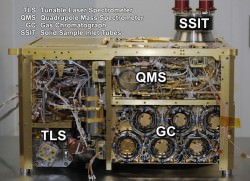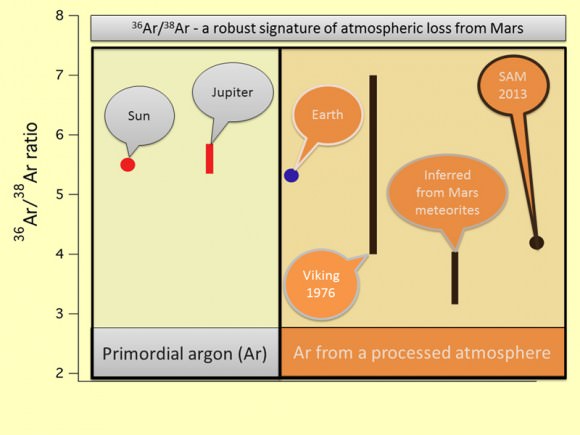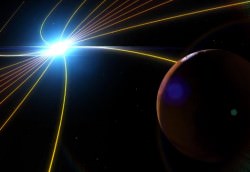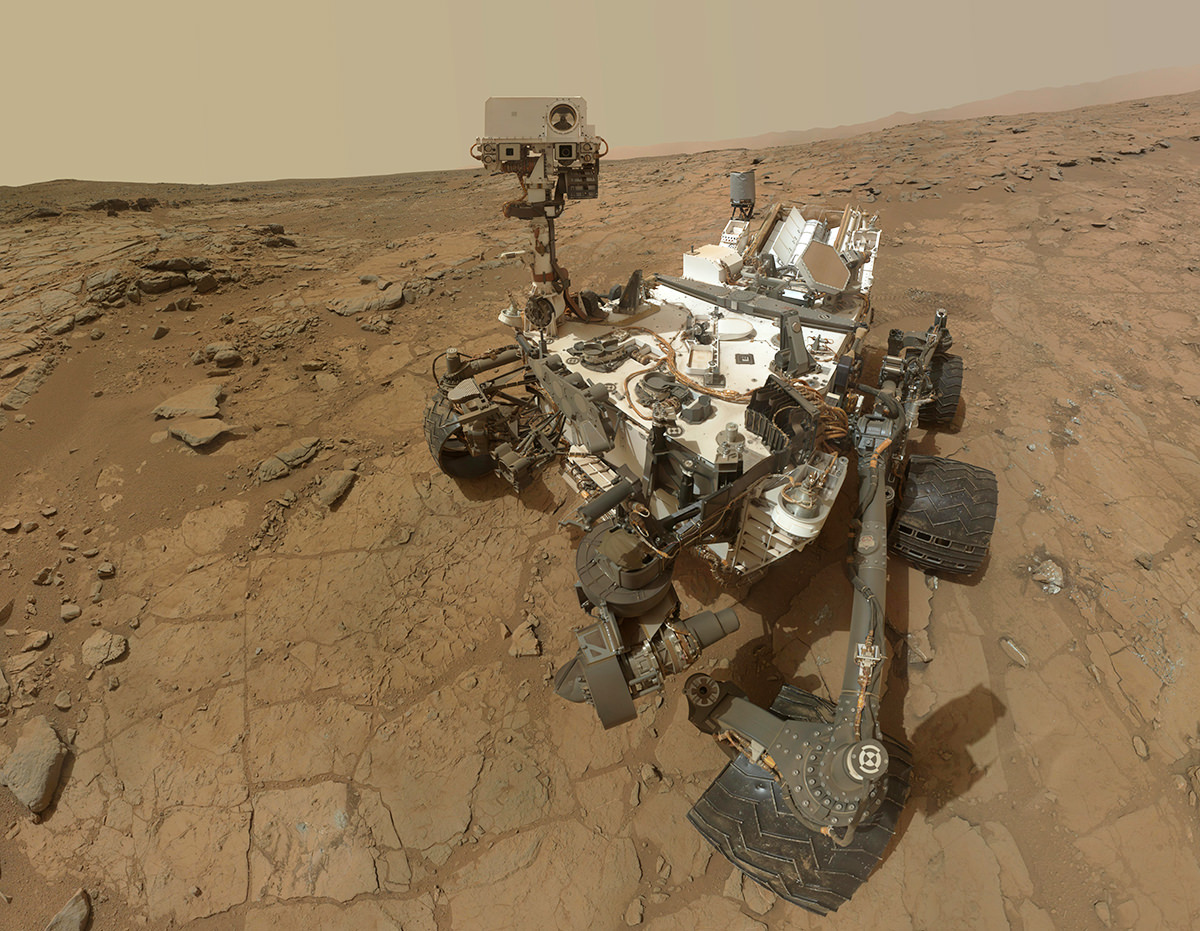Although today Mars’ atmosphere is sparse and thin — barely 1% the density of Earth’s at sea level — scientists don’t believe that was always the case. The Red Planet likely had a much denser atmosphere similar to ours, long, long ago. So… what happened to it?
NASA’s Curiosity rover has now found strong evidence that Mars lost much of its atmosphere to space — just as many scientists have suspected. The findings were announced today at the EGU 2013 General Assembly in Vienna.

Curiosity’s microwave oven-sized Sample Analysis at Mars (SAM) instrument analyzed an atmosphere sample last week using a process that concentrates selected gases. The results provided the most precise measurements ever made of isotopes of argon in the Martian atmosphere.
Isotopes are variants of the same element with different atomic weights.
“We found arguably the clearest and most robust signature of atmospheric loss on Mars,” said Sushil Atreya, a SAM co-investigator at the University of Michigan.
SAM found that the Martian atmosphere has about four times as much of a lighter stable isotope (argon-36) compared to a heavier one (argon-38). This ratio is much lower than the Solar System’s original ratio, as estimated from measurements of the Sun and Jupiter.

This also removes previous uncertainty about the ratio in the Martian atmosphere in measurements from NASA’s Viking project in 1976, as well as from small volumes of argon extracted from Martian meteorites retrieved here on Earth.
These findings point to a process that favored loss of the lighter isotope over the heavier one, likely through gas escaping from the top of the atmosphere. This appears to be in line with a previously-suggested process called sputtering, by which atoms are knocked out of the upper atmosphere by energetic particles in the solar wind.

Lacking a strong magnetic field, Mars’ atmosphere would have been extremely susceptible to atmospheric erosion by sputtering billions of years ago, when the solar wind was an estimated 300 times the density it is today.
These findings by Curiosity and SAM will undoubtedly support those made by NASA’s upcoming MAVEN mission, which will determine how much of the Martian atmosphere has been lost over time by measuring the current rate of escape to space. Scheduled to launch in November, MAVEN will be the first mission devoted to understanding Mars’ upper atmosphere.
Find out more about MAVEN and how Mars may have lost its atmosphere in the video below, and follow the most recent discoveries of the MSL mission here.
Source: NASA/JPL


Profoundly good news!*
I read somewhere that this light Ar loss translates to something like a 80-90 % loss of the initial atmosphere. That is a nice test of the implications of Curiosity’s earlier observation of the D/H ratio being 5 times that of Earth, everything else alike a 4/5 loss of hydrogen. [ http://www.planetary.org/blogs/emily-lakdawalla/2012/12051713-curiosity-sol-117-agu.html ]
But this observation is much more profound since Ar ratios are initially the same in the system while D/H ratios vary smoothly due to the water freeze point, and since H is so easily lost.
So now we know for certain that the early Mars was as habitable as Earth. That the atmosphere pressure at that time was perhaps still only 10 % of Earth’s today (as Mars’ atmosphere pressure today is 1 % of ours) doesn’t matter much for any early ocean life.
This also translates to a validation of the recent reassessment of the radiative habitable zone of stars (as opposed to the tidal habitable zone of gas giants), where a CO2 atmosphere terrestrial at Mars’ location was predicted to be habitable.
* Now one could be anxious about the current water supply in the crust for any extant life, since the current visible WEG (Water Equivalent to a Global layer) is ~ 30 m and the early WEG is projected to have been ~ 500 m. [ http://en.wikipedia.org/wiki/Water_on_terrestrial_planets ] I.e. these tentative figures are consistent with the general volatile loss.
But water froze out globally between then and now, which hopefully caught more of that volatile than others. If there isn’t a substantial subsurface ice reservoir, which melts we see recent historically and annually even today, I will happily eat a mouthful of martian dirt,
Tor, with no tectonic plates, wasn’t that a key factor?
Habitability and habitability zones is (a set of) rough measures, akin to “Earth like” (Earth massed in the radiative HZ) and “Earth analogs” (Earth like around a Sun like star). They embody perturbation analysis, starting with what we know and expanding useful systems as we go. As we learn more about early and sustained biospheres, I’m sure it will be elaborated.
For example, the tidal habitability zone of gas giants don’t demand plate tectonics, since ice moons with oceans between ice and crust (Europe, Enceladus, perhaps more in our system) are putatively long term habitable anyway.
Thanks Tor. I didn’t even give the tidal view an ounce of thought. I was under the impression plate tectonics is a ‘must have’ & is an immeasurable fact for a earth like planet. Your details a really impeccable. If anyone in here would know. It would be you. Thanks again.
You already answered me Tor, ..thanks…
Mmmm.. What would be really cool would be if MAVIN found a magnetic field bubble somewhere on Mars strong enough to deflect a significant portion of high energy particles.. a useful location!
If the sun is responsible in this manner, how did Mars get its’ atmosphere in the first place ? Seeing as the sun has always been there, what changed ?
Some of the early atmosphere of large terrestrial may have been remains of the planetary disk, akin to how gas giants gets their atmosphere by core accretion.
However most of the initial atmospheres of terrestrials is believed to constitute of outgassing as the body differentiated (got a molten core and often initial lava oceans on the surface) under gravity and impact heating.
In the case of Earth, it is likely we had a somewhat dense CO2 (and initially H2) atmosphere more the one Venus still has. Most of the carbon was sequestered (taken up and hidden away) by the crust and mantle (aided by plate tectonics), and the oxygen was similarly sequestered in rocks, water and later a large part of the atmosphere again. Venus was too hot to do any of that, and seems to have lost its hydrogen (and so water) to space.
Mars has likely had a less profound atmospheric dynamics, but who knows? MAVEN may well give us a surprise.
Nice answer. Thank you.
I wonder how much influence microbial life forms, if they ever existed on Mars, could have had on that atmosphere. And could it be reversed.